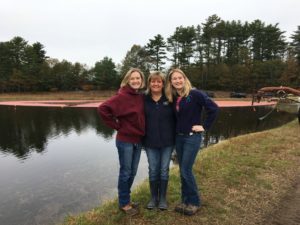Michele Payn's Blog, page 4
November 10, 2020
Compassion is key to solving hunger: Episode 68
“Food elitist ideas are a problem, not a solution for hunger.” We continue our focus on hunger and food insecurity with a poignant conversation about compassion with Clancy Harrison of The Food Dignity Project. Clancy is a self-professed “recovering food snob” and shares stories of how her group is fighting the stigma and shame of food insecurity by serving PEOPLE first.
Clancy Harrison challenges the way hunger is approached in the United States as a registered dietitian, TEDx speaker, and food access strategist. She is The Food Dignity® Project creator, a strategic consulting program for organizations that want to strengthen health outcomes and shift how they approach healthcare. Her mission to demolish the stigma surrounding food assistance programs places her on the cutting edge of advocacy.
Key points:
Being a food snob increases the stigma of hunger:
Food elitist ideas are a problem, not a solution for hunger
People experiencing food insecurity don’t have the same choices as those who are privileged to afford the “right” food
We have to understand the “why” behind food choices. A flavored yogurt may be a treasured gift for a child – but causes shame for the parent if they are told it isn’t a healthy choice
Privileged people often create fear around food by calling it toxic, unhealthy, etc.
Serving hungry people with dignity:
Change the environment where food is received
Ask volunteers, “What are you good at?” and humanize the experience
Giving every kid in the cat a balloon animal makes the trip fun
Volunteers are encouraged to take food to cut food waste and to share recipes (what to do with a rutabaga)
COVID impact on hunger
In March, the need for food services increased by 1700%
Shifted to “Truck to Trunk” service where people stay in their vehicles
A month’s worth of food was distributed in 3 hours
Lost elderly volunteers
Three tips to overcome food bullying:
Ask why and have compassion
Know others do not have the same choices
Remember a story
Links:
Clancy Harrison Website: www.clancyharrison.com
Facebook: https://www.facebook.com/ClancyHarrisonRD
Instagram: https://www.instagram.com/clancyharrison/
Twitter: https://twitter.com/ClancyCHarrison
Clancy’s Recent Video about Food Bullying: https://www.facebook.com/clancycash/posts/10224210111345153
Food Bullying by Michele Payn: http://foodbullying.com
Embrace Your Heart with Eliz Greene: http://www.embraceyourheart.com/
Food Bullying Podcast’s Facebook Page: https://www.facebook.com/foodbullyingpodcast
The post Compassion is key to solving hunger: Episode 68 first appeared on Cause Matters.
November 3, 2020
How do you listen to hunger? Episode 67
Our November hunger series kicks off with one of our favorite guests, anti-hunger advocate Diane Sullivan. She shares how COVID-19 has impacted people who are experiencing food insecurity. For example, did you know people who use SNAP benefits aren’t able to use grocery delivery services that have been essential to many who are at high risk?
Diane Sullivan is a mother and a grandmother with lived experience and hunger and is currently a SNAP recipient. She is an anti-hunger advocate focused on food affordability working to ensure everyone has access to safe, affordable, nutritious food or regardless of income.
Key points:
COVID-19 has presented new challenges for people who need food assistance:
SNAP (formerly Food Stamp) recipients cannot use grocery delivery services which forces people with underlying conditions to go to the store.
SNAP recipients could not stockpile food as we were advised to do at the beginning of the pandemic.
Unemployment payments put people over the income cap to receive SNAP benefits, but then when the payments stop they have to reapply. This created an administrative nightmare.
The pandemic highlighted inequities:
People were already living with limited housing, food, and healthcare resources.
Many people found themselves needing resources but didn’t know where to find them.
People deserve a choice in the food they receive, but the demand for food support during the pandemic has removed much of the choice. People wait in long lines to receive a random bag of food.
People still have to leave home to receive food.
People deserve choice and safe access to nutritious food.
Where to find resources:
Look online to apply for SNAP benefits.
Feeding America is a great resource for immediate needs from Food Banks (that buy food to distribute) and Food Pantries (that distribute food).
We haven’t solved the problems of hunger and poverty because we aren’t listening to the people who have lived experience:
People with lived experience need to be treated like experts and reimbursed for their time and travel.
We need to solve the problems that exist, not those that don’t.
We need to advocate for efficiency.
Three tips to overcome hunger and food insecurity:
Keep educating yourself.
Don’t fall victim to the manipulation of clever food marketers. Don’t sway the market toward more expensive food.
Learn to engage people with lived experience in hunger.
 Links:
Links:
Diane on Twitter: https://twitter.com/FoodChoices4All
Food Bullying book by Michele Payn: http://foodbullying.com
Embrace Your Heart with Eliz Greene: http://www.embraceyourheart.com/
Food Bullying Podcast’s Facebook Page: https://www.facebook.com/foodbullyingpodcast
The post How do you listen to hunger? Episode 67 first appeared on Cause Matters.
October 27, 2020
Growing cranberries and sustainability: Episode 66
Cranberries! One of the stars of autumn tables evokes beautiful images, wonderful scents, and a distinct taste. We discover how cranberries are grown and harvested sustainably in this episode, plus why we shouldn’t be afraid of the “sugar” in these nutritious berries. We also learn how a cranberry bog in Massachusetts looks different than a cranberry bog in Wisconsin.
Michele and Eliz are joined by Dawn Gates-Allen, a fourth generation cranberry grower, who believes that the future of agriculture is through continuing education. Collaborating with schools, realtors, universities and stewardship is a foundation; culminating these while not being afraid to embrace things that are tough will help raise awareness of what agriculture offers to our environment and at your table. Ultimately food education and good decision making is what makes us healthy and well balanced.
 Key points:
Key points:
How are cranberries grown?
What you see on the commercials is a glamorized version of harvest. Cranberry bogs are flooded for harvest, but aren’t grown in water.
Cranberries don’t like to have “wet feet.” Cranberries are grown on a vine with shallow roots.
Durning growing season the cranberry bog looks like a lovely golf course with ditches for irrigation.
Water is recycled and stored in reservoirs and ponds – It is very scenic.
One of the largest managers of water in the state.
How does technology help make the farm more sustainable?
Remote control irrigation is used to provide the right amount of water at the right time.
Everything is done by satellite through solar powered sensors.
Sensors report the temperature and soil moisture conditions in the bog.
Water is used to protect plants from both frost and heat.
How does a cranberry bog in Massachusetts look different than a cranberry bog in Wisconsin?
When cranberries farms in Massachusetts started in the 1880s, they were built in the wetlands around rocks and trees. They are unevenly shaped and require more labor to harvest
Farms in Wisconsin are more open and rectangular. They are built with dykes around them so that machinery can be used to harvest.
What about all the sugar in cranberries?
As with any food, portion control is important.
Cranberries have lots of health benefits.
Lots of recipes call for whole, unsweetened cranberries.
Much of Dawn’s work with realtors is educating them and new home owners about what to expect living near a working farm.
 Three tips to overcome Food Bullying:
Three tips to overcome Food Bullying:
Keep an open mind.
Know your sources.
Freeze cranberries. They keep up a year! Don’t let the sugar thing worry you.
Links:
Dawn Gates-Allen Website: www.cranberries.org
Facebook: https://www.facebook.com/MassCranberries
Twitter: twitter.com/MassCranberries
Food Bullying Podcast’s Facebook Page: https://www.facebook.com/foodbullyingpodcast
Food Bullying with Michele Payn: http://foodbullying.com
Embrace Your Heart with Eliz Greene: http://www.embraceyourheart.com/
The post Growing cranberries and sustainability: Episode 66 first appeared on Cause Matters.
October 20, 2020
Food bullying in the pet aisle: Episode 65
We’ve all seen the ads for pet food featuring happy dogs with happy owners who buy the very best food for their furry family members. But is that food better? How do you know what is best for your pet? Does grain-free dog food make sense or are you being food bullied into buying a boutique brand that offers less nutrition? Our guest, veterinarian Tammy Lons, gives us the scoop on the facts about pet food.
Tammy Lons is a small animal veterinarian. She has two degrees from Michigan State University, a B.S. in animal science, and a D.V.M. She is a wife, mom, practice owner, hobby farmer who raises Dexters.
Key points
How to choose the right food for your pet:
Talk to your veterinarian:
What your pet needs depends on their stage of life, size, and activity level
Most pets are overfed – 75% are obese
Dogs often get the wrong kind of food
Cats don’t need the carbs in kibble and should get canned food most of the time
Vets don’t receive kickbacks from pet food manufacturers and will recommend what is best for your individual pet
Tammy recommends Purina, Royal Canine, and Purina. They are the top 3 brands.
Stick with food companies that do research (feeding trials)
Look for the AFFCO label which gives feeding instructions, calorie counts and a statement about life stage
Ingredient lists are a source of misinformation and bullying
Dogs and cats like grain. It tastes good
By-products and left-overs from people food and are fine
High-protein, grain-free diets are causing heart disease in animals (UC-Davis Study)
Ignore the ads for pet food:
Ads are all marketing and are not required to provide real nutrition information
Companies have big budgets for ads to appeal to your senses
Companies sent people to train staff at PetCo and other retailers to recommend their products to customers using misleading claims such as:
Meat should be the first ingredient
By-products are bad
Pets need grain-free diets
Three tips to overcome Food Bullying when buying pet food:
 Feed one of the top three brands
Feed one of the top three brandsTalk to your vet
Ask questions
Links:
Website: www.Tekonshaanimalhospital.com
Facebook: facebook.com/tekonshaanimalhospital
Instagram: instagram.com/tekonshaanimalhospital
Resources: https://www.aafco.org/
Food Bullying with Michele Payn: http://foodbullying.com
Embrace Your Heart with Eliz Greene: http://www.embraceyourheart.com/
Food Bullying Podcast’s Facebook Page: https://www.facebook.com/foodbullyingpodcast
The post Food bullying in the pet aisle: Episode 65 first appeared on Cause Matters.
October 13, 2020
Why do farmers sign contracts to use GMO seeds? Episode 64
Did you know popcorn is an entirely different crop that the sweet corn you enjoy on the cob? Eliz didn’t! Michele and Eliz welcome Brian Scott to talk about popcorn, sweet corn, field corn, GMOs, and why seeds are intellectual property.
Brian is a corn, soybean, popcorn, and wheat farmer in northwest Indiana raising two young boys on the farm with his wife, Nicole. He started The Farmer’s Life blog in 2011 as a way to reach out to people across the world who don’t have farming as a part of their daily life.
Key points:
What is the difference between sweet corn, field corn, and popcorn?
Field corn harvested when dry
Sweet corn harvested when juicy
Popcorn outside of kernel thicker than sweet corn
Sweet corn and & popcorn account for about 1% of all corn grown
Field corn goes to animal feed, corn oil extraction, or ethanol
Why is some corn labeled GMO, but not all?
There is no GMO popcorn.
Most sweet corn is modified to keep worms out of the plant. If the worm takes a bite, the worm dies. Farmers don’t have to spray the plants to protect them.
Field corn is modified to allow farmers to keep weeds from taking nutrients, light, and water from the plants. This allows farmers to use a single herbicide.
Why do farmers have to sign a contract with seed companies?
It takes tremendous effort and money to create a new seed product.
A farmer can choose which seeds will work best in their fields. They are not under corporate control.
Farmers don’t “save seeds” to plant next year because the offspring isn’t the same as the original. Planting equipment is also very precise. The machinery needs very consistently sized and clean seeds.
 Three tips to overcome Food Bullying:
Three tips to overcome Food Bullying:
Don’t pay attention to labels
Eat what tastes good to you
Know farmers care about the environment
Links:
Brian Scott Website: thefarmerslife.com
YouTube: https://www.youtube.com/user/thefarmerslife03
Facebook: www.facebook.com/thefarmerslife
Instagram: https://www.instagram.com/thefarmerslife/
Twitter: https://twitter.com/thefarmerslife
Food Bullying with Michele Payn: http://foodbullying.com
Embrace Your Heart with Eliz Greene: http://www.embraceyourheart.com/
Food Bullying Podcast’s Facebook Page: https://www.facebook.com/foodbullyingpodcast
The post Why do farmers sign contracts to use GMO seeds? Episode 64 first appeared on Cause Matters.
October 6, 2020
Cancer, chemicals, and feeding your soul: Episode 63
There is a critical time between diagnosis and treatment when patients are vulnerable and searching for anything to control. Too often, people receive lots of unsolicited, non-science-based advice about what they should and shouldn’t eat to get rid of cancer. Patients will run with advice, even if it is not supported by science, just to have some action to take. Unfortunately, that advice can make them miserable and can interfere with their treatment. Julie Lanford sheds light on the truth about cancer treatment and food.
Julie Lanford is a Wellness Director for Cancer Services, a non-profit in Winston-Salem, NC. She is a registered dietitian, licensed nutritionist, and board-certified specialist in oncology nutrition with over 10 years of experience working in oncology. Julie is the creator of CancerDietitian.com and The Cancer Dietitian Podcast, both functioning to translate evidence-based nutrition guidelines into consumer friendly messages for everyday life.
Key points:
Patients are fed lots of myths, including:
Sugar feeds or causes cancer or causes tumors to grow
Organic food are toxin-free and conventional foods need to be avoided
Acidic diets cause cancer
Soy causes breast cancer to grow
Microwaves and non-stick pans are dangerous
Taking action on myths can lead to malnutrition, a serious issue for people going through cancer treatment, and poorer outcomes.
Patients lose time, energy, and enjoyment during treatment through food bullying. They miss out on:
Enjoying foods they love
Good, balanced nutrition
Mealtime gatherings
Going out to eat
Feeling worse than they could due to losing weight or malnutrition
Cancer nutrition is a unique field:
Not many dietitians are trained in oncology nutrition
Few doctors are trained or have access to evidence-based information
Lower-income and minority patients are more impacted by food bullying:
Nutrition services are not always covered by insurance
Many patients don’t have access or unable to afford services because cancer treatment is so expensive.
Lower income people are diagnosed at a later stage
“Myth” based recommendations are more expensive
Nutrition education staff needs to be diverse to deliver culturally appropriate advice.
3 tips to overcome Food Bullying after cancer diagnosis:
Stay positive – focus on what your body needs not on what to avoid
Use the 80/20 rule: feed your body 80% of the time and your soul 20% of the time. All food has a place.
Keep calm and eat your veggies.
Links:
Julie Lanford websites: www.cancerdietitian.com or www.cancerservicesonline.org
Podcast: www.cancerdietitianpodcast.com
References:
Food Bullying by Michele Payn: http://foodbullying.com
Embrace Your Heart with Eliz Greene: http://www.embraceyourheart.com/
Food Bullying Podcast’s Facebook Page: https://www.facebook.com/foodbullyingpodcast
The post Cancer, chemicals, and feeding your soul: Episode 63 first appeared on Cause Matters.
September 29, 2020
Snakes, stigmas, & neophobia in the pandemic: Episode 62
What role does disgust play in our fear of disease? Why should we be careful about the language used to describe disease? Dr. Tyler Davis is back to discuss how exotic foods are associated with “otherness.” Neophobia (fear of new things) creates stigmas. Bonus, Michele expresses her feelings about snakes. It’s a great start to Season 7!
Dr. Tyler Davis is an associate professor of psychological sciences at Texas Tech University, where he directs the Cap Rock Lab. The Cap Rock lab is something that uses functional in neuro imaging to study cognitive neuroscience in categories, categorization, attitudes, and preference.
Key points:
We need to be careful about the language we use to describe disease because if we are unfamiliar with something there is more chance of misinformation.
If people believe a disease, such as Covid-19 originated from an exotic food source it is perceived as more risky and this creates a stigma around the disease and the country of origin.
In the United States, we don’t typically eat bats or snake (although some people eat rattlesnakes). We often don’t understand the importance of these animals to the food chain. For example, bats control malaria by eating insects and are pollinators.
People also generalize the perceived risk of exotic foods (or disease) with the people who eat it.
Neophobia is the fear of new things. This plays into food bullying as identity-based avoidance technology, such as non-GMO, contributes to fear. Labels like “natural” prey on this fear.
To change perceptions we need to focus on the values of the group and how they identify around a fear.
 Three tips to overcome food bullying:
Three tips to overcome food bullying:
Think about how food relates to your values
Check that food claims actually mean what you think they mean. Ask why people want you to believe or identify with the claim.
Don’t assume people are different because they eat differently.
Links:
Dr. Tyler Davis on Twitter: https://twitter.com/flatlandneuro
Email: h.davis@ttu.edu
Food Bullying book with Michele Payn: http://foodbullying.com
Embrace Your Heart book with Eliz Greene: http://www.embraceyourheart.com/
Food Bullying Podcast’s Facebook Page: https://www.facebook.com/foodbullyingpodcast
The post Snakes, stigmas, & neophobia in the pandemic: Episode 62 first appeared on Cause Matters.
September 22, 2020
Fruits & veggies as a love language: Episode 61
Do you wonder which apple will taste the best, or which is healthier? Our guest today writes a very popular blog that inspires people to eat more produce. Lori Taylor also started using TikTok to illustrate how eating produce is love language for your body.
Lori is the founder & CEO of The Produce Moms. For 10 years she sold fresh produce to over 300 grocery stores in the United States . Today, The Produce Moms serves as the leading destination and community for consumers to gain education about fruits and vegetables and transparent truth about agriculture. The Produce Moms mission is to help people of all ages understand that fruits and vegetables are the ultimate choice in food.
Key points:
Why did you start The Produce Moms?
In 2012 there was no place online to learn about produce, and more than 200 items in produce department. Millennial moms were consuming information differently and wanted information about plants, growers, the best time for taste. As part of Lori’s job, she pitched a blog with a friendly approachable tone. For three years she wrote and was the spokesperson for The Produce Mom Blog. In 2015 the company decided to end their involvement in the blog, Lori bought it, and rebranded it as The Produce Moms.
What is the top question your get on The Produce Moms?
People are confused and want to know where to find good information. The Produce Moms blog is intended to provide quality information and the inspiration to eat more produce in an environment where anyone can create a platform. Many platforms are rooted in passion, not fact. People think organic and local means healthy and fear that traditionally grown produce is loaded with pesticides. Lori’s organization shares information about how the economy and consumer choice drive different types of production.
How does food bullying impact low income people and increase food insecurity?
Misinformation such as the “Dirty Dozen” list scares people away from buying produce. Produce is nutrient rich and essential. Food security is national security in and human security. We need to focus on nutrition not just calories. The nutrition panel for produce is the same regardless of how it is grown. It is all healthy.
Childhood nutrition is especially important. We need to push government leaders to have the best interests of children/students up front. All forms of produce (fresh, frozen, and canned) are good choices. Promoting fresh produce, which is most nutrient dense, is important. If we moved toward free school meals for everyone, we would improve childhood nutrition for all and remove the stigma.
 3 tips to overcome Food Bullying:
3 tips to overcome Food Bullying:
Food is culture – celebrate life & family history
Fruits and vegetables are the ultimate choice. ALL choices are good choices.
Don’t overthink it! Don’t stress out over which fruit or veggie to choose. Do you. Don’t beat kids up if they don’t like something – try something else.
Links:
Lori Taylor website: www.theproducemoms.com
Facebook: https://www.facebook.com/TheProduceMoms
Instagram: instagram.com/theproducemoms
Twitter: twitter.com/theproducemom
Pintrest, YouTube & TicTok: @theproducemoms
Have you liked the podcast’s Facebook Page? https://www.facebook.com/foodbullyingpodcast
Food Bullying with Michele Payn: http://foodbullying.com
Embrace Your Heart with Eliz Greene: http://www.embraceyourheart.com/
The post Fruits & veggies as a love language: Episode 61 first appeared on Cause Matters.
September 15, 2020
How to vet information in the media: Episode 60
Ever wonder if that tasty sound bite on the news about what you eat is true? Our guest, journalist Kate Delaney, shares how to vet what you hear and why a sensational headline is more likely to get media attention.
Emmy award-winning talk show host and speaker Kate Delaney’s talk show “America Tonight” is syndicated across the U.S. and is heard in 20 other countries. In the 15 years of the show, she has broadcast from Ireland, Grenada, Ecuador and many other countries. A big part of her on the roadshows include food.
Key points:
There isn’t enough time to delve into sources and proof in a short-form radio or television story. Viewers and ratings are important. An attention-grabbing headline or juicy sound bite is key to making the format work.
Kate likes the longer format of a talk show because she can dig deeper into topics. She knows 25 to 54-year-old people are concerned about food and want health information. In the longer format, she can give sources, doe research, and more “meat on the bone.”
90% of a pitch to be on a show is selling a point of view. The media are interested in hearing from people on the front lines of producing food. If you see or hear misinformation, reach out to the host or reporter and offer another point of view. Reporters have to file stories. Feeding the beast of the media will pay off.
Three tips to vet media stories and fight food bullying:
If you see something sensational, go deeper. Don’t trust the information at face value; get more information.
Follow reliable, trusted sources who provide sources and details.
Have your guard up. The goal of the media is to serve who pays to keep them in front of you.
 Links:
Links:
Kate Delaney websites: katedelaneyradio.com and dealyourowndestiny.com
Facebook: facebook.com/katedelaneyfanpage
Instagram: instagram.com/katedelaneyspeaker
Twitter: twitter.com/katesdelaney
Food Bullying with Michele Payn: http://foodbullying.com
Embrace Your Heart with Eliz Greene: http://www.embraceyourheart.com/
Have you liked the podcast’s Facebook Page? https://www.facebook.com/foodbullyingpodcast
The post How to vet information in the media: Episode 60 first appeared on Cause Matters.
September 8, 2020
Chemicals, hormones, and an anniversary – oh my! Episode 59
 Fifty eight episodes have flown by and here we are, a year into the Food Bullying Podcast! Michele and Eliz reflect on the first anniversary of the podcast with a look at some of their favorite episodes. Listen for more insight on nutrition, neuroscience, farming, exercise, GMOs, healthy eating, hormones, science, and wellness.
Fifty eight episodes have flown by and here we are, a year into the Food Bullying Podcast! Michele and Eliz reflect on the first anniversary of the podcast with a look at some of their favorite episodes. Listen for more insight on nutrition, neuroscience, farming, exercise, GMOs, healthy eating, hormones, science, and wellness.
Episode 11: How do you feed a vegan NFL player & a carnivore ballerina?
Leslie Bonci talks about how nutrition can give you a competitive advantage.
https://causematters.com/advocacy/vegan-football-carnivore-ballerina/
Episode 12: How does food bullying cost hungry people?
Diane Sullivan shares why we should shop with our wallets to help those living in food insecurity.
https://causematters.com/advocacy/how-does-food-bullying-cost-hungry-people/
Episode 16: How is your brain being manipulated about food?
Dr. Tyler Davis explains how emotional responses to GMOs and hormones, sustainability and antibiotics impact our impressions of food.
https://causematters.com/advocacy/brain-food-manipulation/
Episode 18: Are you feeding your brain trash?
“Food is such an integral part of our social fabric. It becomes a part of the storytelling process,” but our farming memory is being lost across generations, says Dr. Cami Ryan, a Canadian social scientist.
https://causematters.com/advocacy/brain-trash-food/
Episode 22: How to overcome food anxiety & B.S. health claims
The “health industry” is a business of money, contends Bill Sukala, a Registered Dietitian Nutrition and Clinical Exercise Physiologist in Australia.
https://causematters.com/advocacy/overome-food-anxiety-health-claims/
Episode 25: Are chemicals in food poisoning you?
The Food Science Babe shares, “Whether you can pronounce an ingredient or not has no bearing on whether it’s safe. If you can’t pronounce it, look it up.”
https://causematters.com/advocacy/food-science-babe-chemicals/
Episode 29: How now, brown cow? Why a dairy farmer talks to his cows
Farmer Derrick Josi says, “Some people think I’m crazy when I’m out there lecturing my cows.”
https://causematters.com/advocacy/dairy-farmer-animal-care/
Episode 30: Are you bullying yourself about food?
Cara Harbstreet says, “If we feel that our food choices don’t uphold this ideal standard of how we “should” be eating, there is a harsh cycle of criticism and judgment, often from ourselves.”
https://causematters.com/advocacy/self-food-bullying/
What’s been your favorite episode? What would you like to hear more about? Let us know at the Food Bullying Podcast’s Facebook page!
The post Chemicals, hormones, and an anniversary - oh my! Episode 59 first appeared on Cause Matters.



